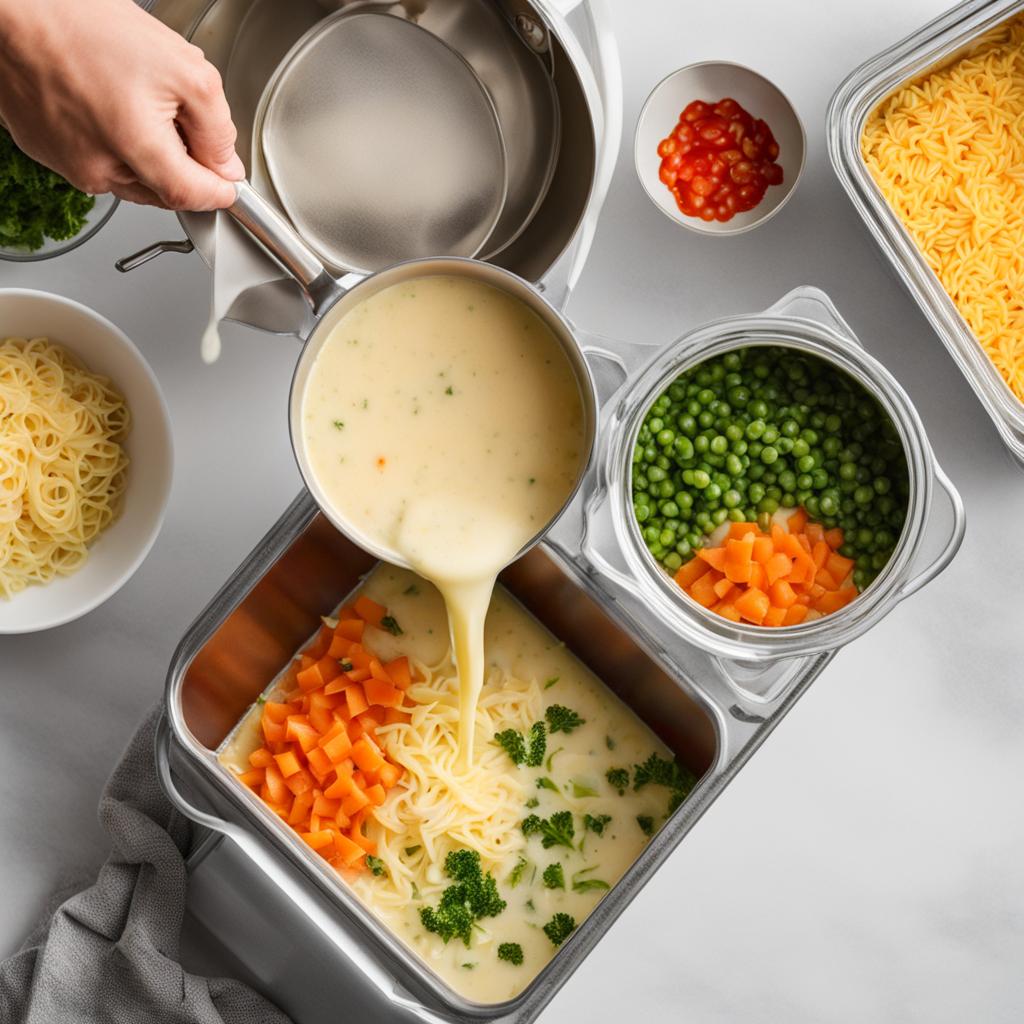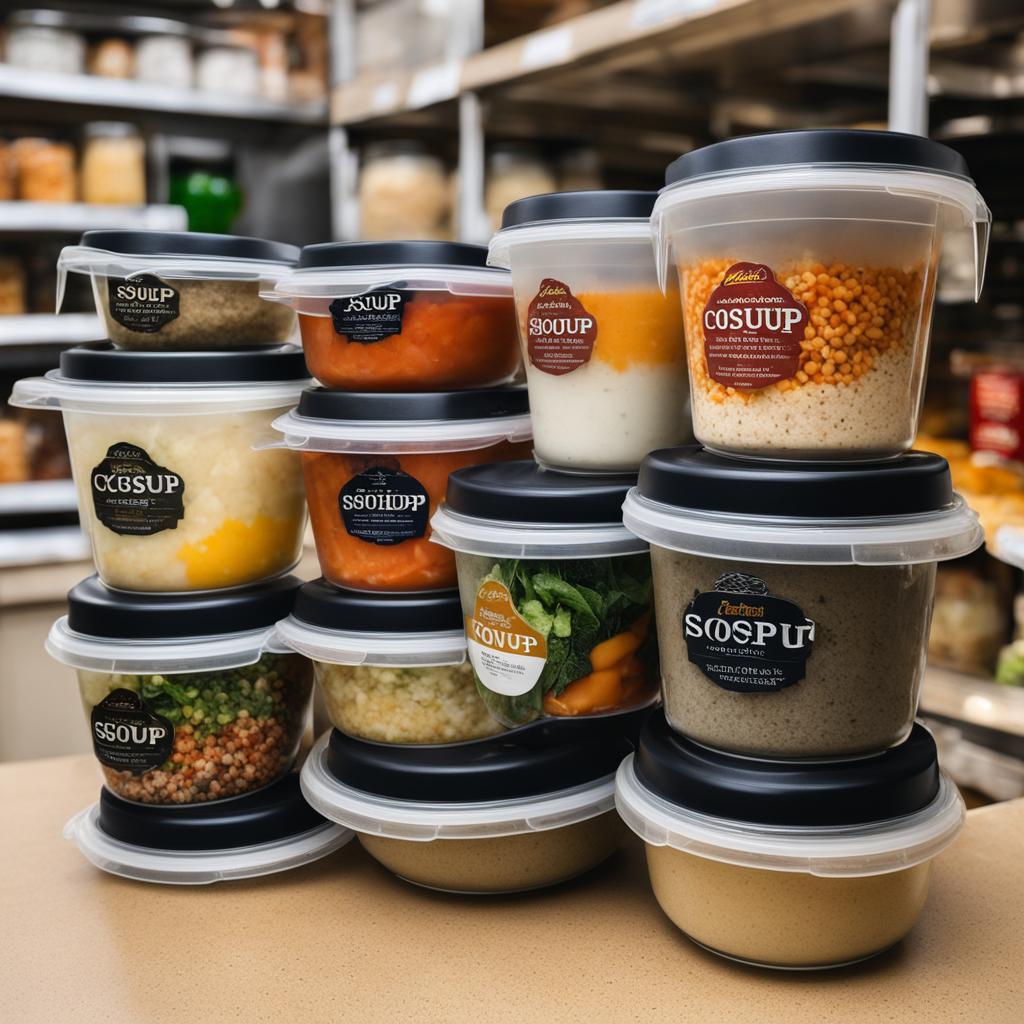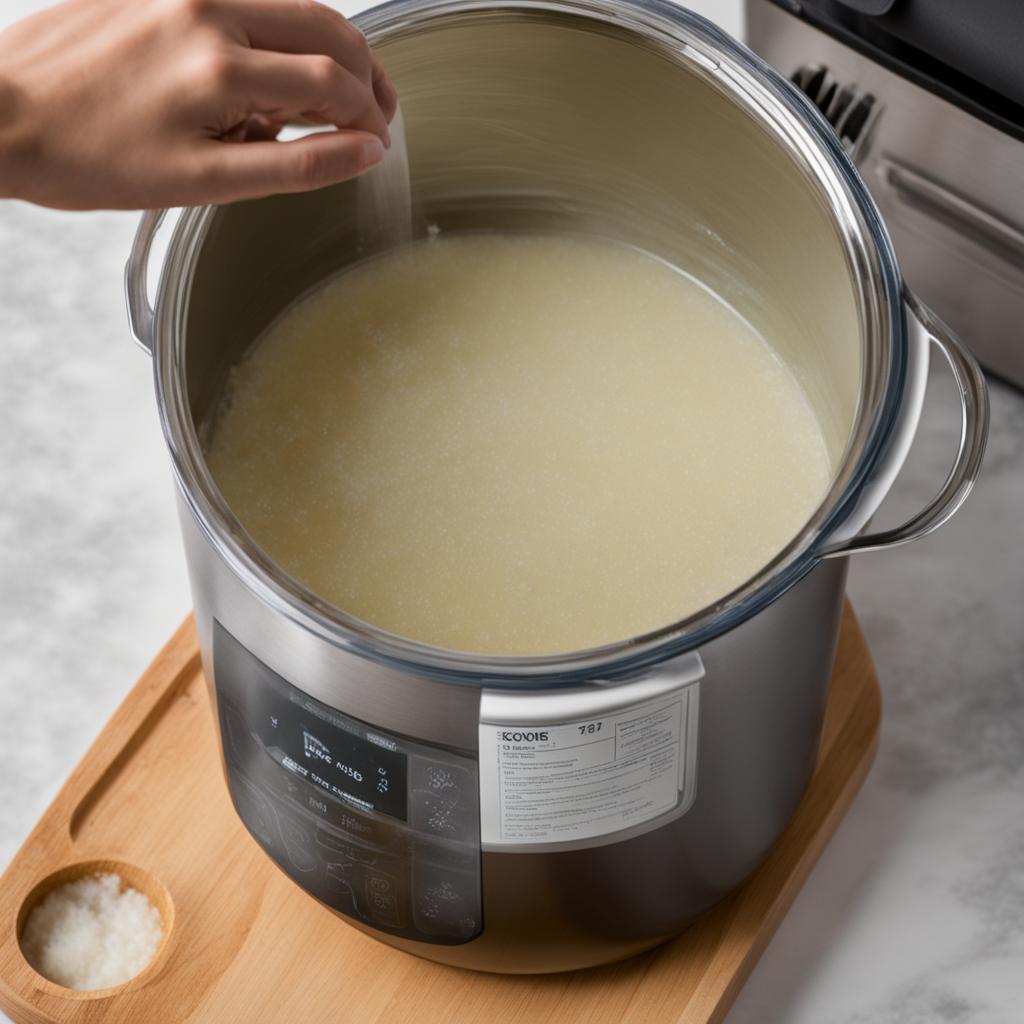Freezing soup is a fantastic way to preserve its taste, texture, and nutrients for future enjoyment. Whether you want to savor the flavors of your favorite homemade soup or stock up on comforting meals for the colder months, freezing soup can ensure that you always have a delicious option on hand.
Key Takeaways:
- Freezing soup is a convenient way to prevent food waste and have ready-to-eat meals at your fingertips.
- Not all types of soups freeze equally well. Broth-based soups generally freeze better than creamy soups or those with rice, beans, or noodles.
- Properly preparing and labeling soup before freezing is essential for maintaining quality and ensuring a safe dining experience.
- Thawing and reheating frozen soup can be done using various methods, such as refrigeration, microwaving, or stovetop heating.
- Labeling and storing frozen soup correctly helps maintain its flavor, texture, and overall quality.
Why Freeze Soup?
Freezing soup is a convenient technique for preserving its flavor and ensuring you always have a delicious meal on hand. By freezing soup, you can prevent food waste and have ready-to-eat meals available for later consumption.
One of the main benefits of freezing soup is that it helps preserve the taste and quality of the soup. When soup is frozen, it locks in the flavors, allowing you to enjoy the same delicious taste even after it has been thawed and reheated.
Freezing soup also offers a practical solution for busy individuals or families. By preparing a large batch of soup and freezing it in portions, you can have a quick and nutritious meal ready in minutes. This can be especially helpful during busy workdays or when you’re looking for a comforting meal on a cold winter evening.
Benefits of Freezing Soup:
- Prevents food waste
- Preserves flavor and quality
- Convenient and time-saving
- Provides quick and nutritious meals
Types of Soups to Freeze
When it comes to freezing soup, not all varieties are created equal. While some soups freeze well and maintain their flavor, others may experience changes in taste and texture. It’s important to know which types of soups are best suited for freezing to ensure a satisfying meal when you’re ready to thaw and reheat.
Broth-Based Soups
Broth-based soups, such as chicken noodle or vegetable soup, generally freeze well and retain their flavor. The high liquid content in these soups helps prevent changes in texture during freezing and thawing. Whether you make a large batch or have leftovers from a meal, freezing broth-based soups is a great way to preserve their taste for later enjoyment.
Creamy and Thick Soups
Creamy soups, like potato or chowders, may not freeze as successfully due to changes in texture. The freezing process can cause the emulsification in these soups to break, resulting in a grainy or separated consistency when thawed and reheated. However, if you still want to freeze creamy soups, it’s best to reheat them slowly over low heat and stir frequently to help restore their creamy texture.
Rice, Bean, and Noodle Soups
Soups that contain rice, beans, or noodles may also undergo changes in taste and texture after freezing. These ingredients can become mushy or soggy when thawed and reheated. If you plan to freeze soups with these additions, consider slightly undercooking the rice, beans, or noodles before adding them to the soup. This extra step can help mitigate the texture changes during the freezing and reheating process.
Summarize
When deciding which soups to freeze, prioritize broth-based varieties that maintain their flavor and consistency when thawed and reheated. Creamy and thick soups may experience changes in texture, while soups with rice, beans, or noodles can become mushy. By choosing the right soups to freeze, you can ensure a delightful taste experience when enjoying your frozen creations.
Table
| Soup Type | Freezing Suitability |
|---|---|
| Broth-Based Soups | Freeze well, maintain flavor |
| Creamy and Thick Soups | May experience changes in texture |
| Rice, Bean, and Noodle Soups | May become mushy or soggy |
Preparing Soup for Freezing
When it comes to freezing soup, proper preparation is key to preserving its flavor and quality. Follow these simple tips to ensure that your soup is ready for freezing:
- Cool the soup: Allow your soup to cool completely before transferring it to freezer-safe containers. Placing the hot soup in an ice bath can speed up the cooling process and prevent potential food safety issues.
- Choose the right containers: Use freezer-safe containers or bags that are specifically designed for freezing. Make sure they have a tight seal to prevent air from entering and causing freezer burn.
- Leave space for expansion: Leave some empty space in the containers to allow for expansion during freezing. This will prevent the containers from bursting and ensure that your soup stays fresh.
- Label the containers: Don’t forget to label your containers with the name of the soup and the date of freezing. This will help you keep track of your frozen inventory and ensure that you use the oldest soup first.
By following these steps, you can prepare your soup for freezing and ensure that it maintains its delicious flavor when you’re ready to enjoy it.
How to Properly Label Frozen Soup
Properly labeling your frozen soup is an essential part of the freezing process. Here are some tips to help you label your soup effectively:
- Name of the soup: Write the name or type of soup on the label so that you can easily identify it in the freezer.
- Date of freezing: Include the date when you froze the soup. This will help you keep track of how long the soup has been in the freezer and ensure that you use it within a reasonable time frame.
- Serving size: If you portioned your soup into individual servings, indicate the serving size on the label. This will make it easier to grab the right amount of soup when you’re ready to thaw and reheat it.
Properly labeled frozen soup will not only help you stay organized but also ensure that you can quickly and easily find the soup you’re looking for.
Table: Comparing Freezer-Safe Containers
| Container Type | Pros | Cons |
|---|---|---|
| Freezer bags | Space-saving, easy to stack, and convenient for storing different portion sizes. | Not reusable, can be punctured or torn easily. |
| Glass containers | Durable, reusable, and safe for reheating in the microwave or oven. | Take up more space in the freezer, may be heavier to transport. |
| Plastic containers | Lightweight, freezer-safe, and come in a variety of sizes and shapes. | Not suitable for microwave or oven reheating, may become stained or warped over time. |
Consider your needs and preferences when choosing the best containers for freezing your soup. Whether you opt for freezer bags, glass containers, or plastic containers, ensure that they are specifically designed for freezing to maintain the quality of your soup.
Soup Freezing Tips: Preserve Flavor and Quality
Freezing soup is a fantastic way to save time and ensure you always have a comforting meal ready to enjoy. However, to freeze soup properly and preserve its flavor and quality, there are a few crucial tips to keep in mind.
Choosing the Right Containers
When it comes to freezing soup, selecting the right containers is essential. Airtight freezer bags and freezer-safe glass or plastic containers are excellent options. Make sure to leave some empty space in the containers to accommodate expansion during freezing.
Sealing and Storing
To prevent freezer burn and maintain the soup’s freshness, it’s crucial to seal the containers tightly. This helps prevent air from entering and affecting the flavor. Once sealed, store the soup flatly in a single layer, allowing for easy stacking and maximizing freezer space.
Labeling for Organization
Properly labeling the frozen soup containers is vital for keeping track of your inventory. Clearly mark each container with the soup’s name and the date it was frozen. This labeling system ensures that you know what you have in the freezer and helps you consume the soup within a reasonable time frame.
By following these soup freezing tips, you can preserve the delicious flavor and quality of your favorite soups, making them readily available whenever you need a comforting and satisfying meal.
How Long Can You Freeze Soup?
When it comes to freezing soup, it’s important to know how long it can stay in the freezer while still maintaining its flavor and quality. Properly storing and freezing soup helps preserve its taste and ensures a delicious meal even after months in the freezer. Let’s explore the soup freezing process, steps, and storage methods to help you enjoy your frozen soup for an extended period.
Generally, soup can be kept in the freezer for up to three months, but it’s recommended to consume it within one to two months for optimal flavor. Over time, the flavors may dilute due to the formation of ice and water during thawing. To maintain the best flavor and quality, it’s crucial to follow the proper freezing and storage methods.

Benefits of Freezing Individual Portions
Freezing soup in individual portions offers several benefits. Firstly, it allows for better portion control, ensuring that you only defrost and consume the amount you need, reducing food waste. Individual portions also cool and freeze more evenly, preserving the flavors and textures of the soup. This means that each serving will taste just as delicious as the day it was made.
When you freeze soup in individual portions, you also enjoy the convenience of having ready-to-eat meals on hand. Whether you’re craving a comforting bowl of chicken noodle soup or a hearty vegetable stew, you can simply grab a portion from the freezer and heat it up without thawing the entire batch. It’s a time-saving solution for busy days or when you’re in need of a quick and satisfying meal.
Freezing soup in individual portions is also a great way to experiment with different flavors and recipes. By freezing smaller quantities, you can easily try out new soup combinations and variations without committing to a large batch. This allows for more creativity in the kitchen and the opportunity to discover new favorite soup flavors.
In summary, freezing soup in individual portions is a practical and versatile method that maximizes convenience and flavor preservation. Whether you’re cooking for one or a family, it’s a smart way to ensure that you always have a variety of delicious soups at your fingertips.
“Freezing soup in individual portions is a time-saving solution for busy days or when you’re in need of a quick and satisfying meal.”
The Benefits of Freezing Individual Portions:
- Better portion control
- Enhanced flavors and textures
- Convenience for quick and easy meals
- Opportunity for recipe experimentation
Freezing soup in individual portions is a practical and versatile method that maximizes convenience and flavor preservation. Whether you’re cooking for one or a family, it’s a smart way to ensure that you always have a variety of delicious soups at your fingertips.
Best Containers for Freezing Soup
When it comes to freezing soup, choosing the right containers is essential to preserve the quality and flavor of your homemade masterpiece. There are several options available, each with its advantages and considerations. Here are some of the best containers for freezing soup:
1. Airtight Freezer Bags
Airtight freezer bags are a popular choice due to their space-saving design and convenience. They are available in various sizes and can be easily stacked once frozen. Make sure to remove excess air from the bag before sealing to prevent freezer burn.
2. Freezer-Safe Glass or Plastic Containers
If you prefer a more durable and reusable option, freezer-safe glass or plastic containers are a great choice. They come in different sizes and shapes, allowing you to portion out your soup according to your needs. These containers provide added protection against freezer burn and are dishwasher safe for easy cleanup.
3. Mason Jars
Mason jars are a charming option for freezing soup, especially if you’re looking for a single-serving solution. They are perfect for individual portions and can be easily labeled for better organization. However, it’s important to leave some headspace in the jar to allow for expansion during freezing.
Regardless of the container you choose, make sure it is labeled with the soup’s name and date of freezing. This will help you keep track of your frozen inventory and ensure that you consume the soup within a reasonable timeframe for optimal flavor.
| Container Type | Advantages | Considerations |
|---|---|---|
| Airtight Freezer Bags | – Space-saving design – Easy to stack – Available in various sizes |
– Requires careful sealing to prevent leaks – Not ideal for liquid-heavy soups |
| Freezer-Safe Glass or Plastic Containers | – Durable and reusable – Dishwasher safe – Provides added protection against freezer burn |
– Takes up more space in the freezer – May be more expensive than other options |
| Mason Jars | – Charming and rustic – Perfect for individual portions – Easily labeled for better organization |
– Requires leaving headspace for expansion – Glass jars may break if not handled with care |
By choosing the best containers for freezing soup, you can ensure that your homemade creations stay fresh and flavorful for future enjoyment. Remember to follow proper storage guidelines and thawing instructions to maintain the quality of your frozen soup.

How to Properly Label Frozen Soup
Proper labeling is an essential step when it comes to freezing soup. By clearly labeling each container, you can maintain organization and keep track of your inventory. This simple practice will save you time and eliminate any confusion when you’re ready to enjoy your frozen soup.
When labeling your containers, be sure to include the name of the soup, serving size, and the date of freezing. This information is crucial in identifying the contents and ensuring that the soup is consumed within a reasonable time frame. It’s also a good idea to use waterproof labels or a permanent marker to prevent smudging or fading over time.
Labeling your frozen soup not only helps with organization, but it also enables you to prioritize consumption based on the date. By following the first-in, first-out (FIFO) method, you can enjoy your soups while they are still at their peak freshness. Additionally, labeling allows you to easily differentiate between various soup flavors, so you can choose the one that suits your mood or dietary preferences.
Table: Example Labeling Guidelines for Frozen Soup
| Container | Soup Name | Serving Size | Date of Freezing |
|---|---|---|---|
| 1 | Chicken Noodle | 2 cups | 10/15/2022 |
| 2 | Tomato Basil | 1.5 cups | 10/20/2022 |
| 3 | Butternut Squash | 2.5 cups | 10/25/2022 |
By diligently labeling your frozen soup, you can maintain a well-organized freezer and ensure that each bowl of soup brings you the same delicious flavors and comfort as the day it was made.
The Importance of Soup Storage Guidelines
Properly storing soup is essential to preserve its quality and flavor. By following the correct soup storage guidelines, you can ensure that your frozen soup remains delicious and safe to consume. Here are some essential tips for freezing soup correctly:
- Freeze promptly: After preparing your soup, it’s important to store it in the freezer as soon as possible. This helps prevent bacterial growth and maintain the soup’s freshness.
- Maintain freezing temperature: Make sure your freezer is set to the proper temperature, usually around 0°F (-18°C). This ensures that the soup stays frozen and prevents the development of ice crystals that can affect its texture and flavor.
- Use appropriate containers: Choosing the right containers for freezing soup is crucial. Opt for airtight freezer bags or freezer-safe glass or plastic containers. These containers help prevent freezer burn and maintain the quality of the soup.
- Label your soup: Properly labeling your frozen soup is important for easy identification. Include the name of the soup, serving size, and date of freezing on each container. This helps you keep track of your inventory and ensures that the soup is consumed within a reasonable time frame.
By following these soup freezing guidelines, you can preserve the quality and taste of your favorite soups for longer periods. Proper storage techniques ensure that the soup maintains its optimal flavor and texture when thawed and reheated.

Tips for Freezing Soup with Meats
Freezing soup with meats requires some additional considerations to ensure food safety and preserve the flavor and quality of the ingredients. Here are some guidelines and techniques to follow when freezing soups that contain meats:
- Cook the meats properly: Before adding meats to your soup, make sure they are cooked thoroughly to a safe internal temperature. This helps reduce the risk of bacterial growth and ensures that the meats maintain their quality during freezing and thawing.
- Freeze the soup promptly: When including meats in your soup, it’s important to freeze it within three to four days of preparation. This helps maintain the freshness of the meats and minimizes the risk of spoilage.
- Store in small, airtight containers: Divide the soup into individual portions or small containers before freezing. This allows for faster freezing and easier thawing of smaller portions as needed. Use airtight freezer bags or freezer-safe containers to prevent air from entering and causing freezer burn.
- Label and date: Clearly label each container with the name of the soup and the date of freezing. This helps you keep track of your frozen inventory and ensures that the soup is consumed within a reasonable time frame.
By following these freezing guidelines and techniques, you can enjoy delicious soups with meats that are safe to consume and retain their flavor and quality.
| Meat type | Freezing guidelines |
|---|---|
| Poultry (chicken, turkey) | Freeze within 3-4 days of cooking. Remove bones and excess fat before freezing. |
| Beef (ground, stew meat) | Freeze within 3-4 days of cooking. Cut into small, bite-sized pieces if desired. |
| Pork (sausage, bacon) | Freeze within 3-4 days of cooking. Slice or chop into smaller portions if desired. |
Conclusion
Freezing soup is a practical and effective way to preserve its flavor and ensure you always have a delicious meal on hand. By following the proper freezing techniques, using the right containers, and labeling the frozen soup, you can enjoy the convenience of having a variety of soups readily available.
Whether you prefer broth-based soups or hearty stews, freezing soup allows you to enjoy a comforting meal whenever you desire, while preserving its quality and taste.
FAQ
How long can you freeze soup?
Soup can stay in the freezer for up to three months if stored properly. However, it’s best to consume frozen soups within one to two months for optimal flavor.
How do you thaw and reheat frozen soup?
Thaw frozen soup overnight in the refrigerator for the safest method. Once thawed, reheat the soup using various methods such as the microwave, stovetop, or an Instant Pot, ensuring it reaches a safe temperature of 165°F.
Can you freeze soup with dairy or pasta?
It’s best to omit adding dairy or pasta before freezing and include them when reheating the soup to preserve their texture and integrity.
Why should you freeze soup in individual portions?
Freezing soup in individual portions allows for better portion control, even freezing, and the convenience of reheating only what is needed.
What are the best containers for freezing soup?
Airtight freezer bags or freezer-safe glass or plastic containers are suitable options for freezing soup.
How should you label frozen soup?
Clearly label each container with the name of the soup, serving size, and date of freezing to maintain organization and keep track of inventory.
Why is it important to follow soup storage guidelines?
Properly storing soup in the freezer promptly after preparation and following storage guidelines helps maintain the quality and safety of the frozen soup.
Can you freeze soup with meats?
Meats in soup should be frozen within three to four days of preparation to maintain freshness and reduce the risk of spoilage.
Source Links
- https://www.spoonfulofcomfort.com/blog/best-way-to-freeze-soup-quick-tips-tricks
- https://www.thekitchn.com/how-to-freeze-soup-23397915
- https://www.southernliving.com/food/how-to/how-to-freeze-and-store-soup
Related Recipes:
 How to Reheat Soup and Keep It Delicious
How to Reheat Soup and Keep It Delicious
 How to Freeze Bananas? (Perfect Step-By-Step Guide)
How to Freeze Bananas? (Perfect Step-By-Step Guide)
 Can You Freeze Stuffing? How to Preserve the Holiday Dish
Can You Freeze Stuffing? How to Preserve the Holiday Dish
 How to Freeze Blackberries: A Guide
How to Freeze Blackberries: A Guide
 How to Freeze Corn: Tips for Freshness
How to Freeze Corn: Tips for Freshness
 Can You Freeze Garlic? Here’s How to Do It Right.
Can You Freeze Garlic? Here’s How to Do It Right.
 How to Thicken Soup: Simple Tricks and Tips
How to Thicken Soup: Simple Tricks and Tips
 How to Freeze Pork: Tips for Maintaining Flavor
How to Freeze Pork: Tips for Maintaining Flavor







